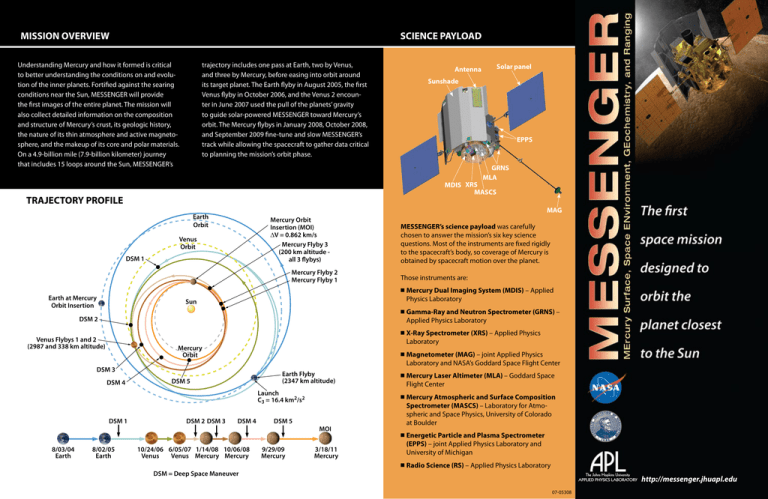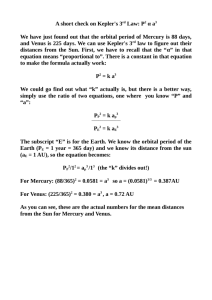MISSION OVERVIEW SCIENCE PAYLOAD
advertisement

MISSION OVERVIEW SCIENCE PAYLOAD Understanding Mercury and how it formed is critical to better understanding the conditions on and evolution of the inner planets. Fortified against the searing conditions near the Sun, MESSENGER will provide the first images of the entire planet. The mission will also collect detailed information on the composition and structure of Mercury’s crust, its geologic history, the nature of its thin atmosphere and active magnetosphere, and the makeup of its core and polar materials. On a 4.9-billion mile (7.9-billion kilometer) journey that includes 15 loops around the Sun, MESSENGER’s trajectory includes one pass at Earth, two by Venus, and three by Mercury, before easing into orbit around its target planet. The Earth flyby in August 2005, the first Venus flyby in October 2006, and the Venus 2 encounter in June 2007 used the pull of the planets’ gravity to guide solar-powered MESSENGER toward Mercury’s orbit. The Mercury flybys in January 2008, October 2008, and September 2009 fine-tune and slow MESSENGER’s track while allowing the spacecraft to gather data critical to planning the mission’s orbit phase. QUICK FACTS Sunshade EPPS GRNS MLA MDIS XRS MASCS TRAJECTORY PROFILE MAG Earth Orbit Mercury Orbit Insertion (MOI) ∆V = 0.862 km/s Mercury Flyby 3 (200 km altitude all 3 flybys) Venus Orbit DSM 1 Mercury Flyby 2 Mercury Flyby 1 MESSENGER’s science payload was carefully chosen to answer the mission’s six key science questions. Most of the instruments are fixed rigidly to the spacecraft’s body, so coverage of Mercury is obtained by spacecraft motion over the planet. Those instruments are: nMercury Dual Imaging System (MDIS) – Earth at Mercury Orbit Insertion Physics Laboratory Sun Applied nGamma-Ray and Neutron Spectrometer (GRNS) – DSM 2 Applied Physics Laboratory n X-Ray Spectrometer (XRS) – Venus Flybys 1 and 2 (2987 and 338 km altitude) Laboratory Mercury Orbit DSM 4 – joint Applied Physics Laboratory and NASA’s Goddard Space Flight Center Earth Flyby (2347 km altitude) DSM 5 Launch C3 = 16.4 km2/s2 DSM 1 8/02/05 Earth DSM 2 DSM 3 Applied Physics nMagnetometer (MAG) DSM 3 8/03/04 Earth Solar panel Antenna DSM 4 10/24/06 6/05/07 1/14/08 10/06/08 Venus Venus Mercury Mercury DSM = Deep Space Maneuver DSM 5 9/29/09 Mercury nMercury Laser Altimeter (MLA) – Flight Center Goddard Space nMercury Atmospheric and Surface Composition MOI 3/18/11 Mercury Spectrometer (MASCS) – Laboratory for Atmospheric and Space Physics, University of Colorado at Boulder nEnergetic Particle and Plasma Spectrometer (EPPS) – joint Applied Physics Laboratory and University of Michigan n Radio Science (RS) – Applied Physics Laboratory The Johns Hopkins University APPLIED PHYSICS LABORATORY 07-05308 http://messenger.jhuapl.edu The Johns Hopkins University APPLIED PHYSICS LABORATORY QUICK FACTS MISSION 3 August 2004 Launch Earth Launch: August 3, 2004, from Launch Pad 17B at Cape Canaveral Air Force Station, Fla., at 2:15:56 a.m. EDT aboard a Boeing Delta II rocket Moon Gravity assist flybys: Earth, August 2005; Venus, October 2006, June 2007; Mercury, January 2008, October 2008, September 2009 2 August 2005 Earth Flyby Enter Mercury orbit: March 2011. Total distance traveled from Earth to Mercury orbit: 7.9 billion kilometers (4.9 billion miles). Spacecraft circles the Sun 15 times from launch to Mercury orbit 24 October 2006 5 June 2007 Two Venus Flybys Venus December 2005–November 2009 Five large course-correction maneuvers SPACECRAFT MESSENGER Spacecraft 18 March 2011 Mercury orbit insertion MESSENGER orbit MESSENGER Cruise Phase Distance traveled: 4.9 billion miles Cruise Duration: 6.6 years 15 trips around the Sun 6 planetary flybys Primary mission at Mercury: Orbit for one Earth year (equivalent to four Mercury years, or two Mercury solar days), collecting data on the composition and structure of Mercury’s crust, its topography and geologic history, the nature of its thin atmosphere and active magnetosphere, and the makeup of its core and polar materials Size: Main spacecraft body is 1.42 meters (56 inches) tall, 1.85 meters (73 inches) wide and 1.27 meters (50 inches) deep; front-mounted ceramic-fabric sunshade is 2.5 meters tall and 2 meters across (8 feet by 6 feet); two rotatable solar panel “wings” extend about six meters (20 feet) from end to end across the spacecraft Launch weight: Approximately 1,107 kilograms (2,441 pounds); includes about 599 kilograms (1,320 pounds) helium pressurant and propellant and 508 kilograms (1,121 pounds) “dry” spacecraft and instruments Power: Two body-mounted gallium arsenide solar panels; nickel-hydrogen battery Mercury 4 January 2008 1 6 October 2008 29 September 2009 Three Mercury Flybys Propulsion: One bipropellant (hydrazine and nitrogen tetroxide) thruster for large maneuvers; 16 hydrazinefueled thrusters for small trajectory adjustments and attitude control Science instruments: Wide-angle color and narrowangle monochrome imager; gamma-ray and neutron spectrometer; X-ray spectrometer; energetic particle and plasma spectrometer; atmospheric and surface composition spectrometer; laser altimeter; magnetometer; radio science experiment



